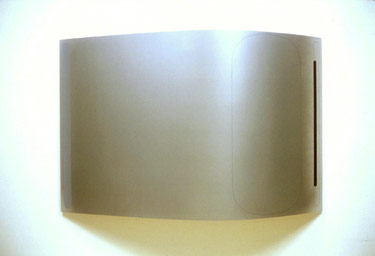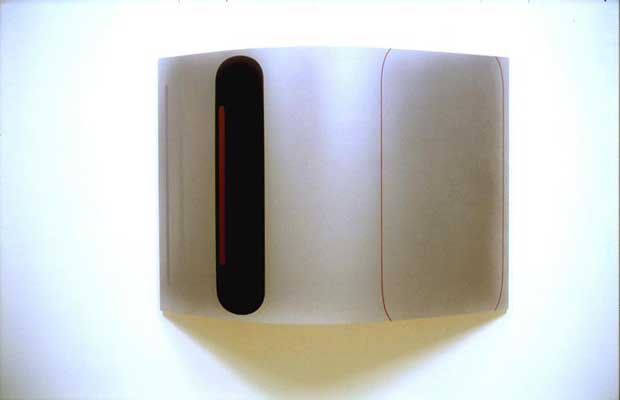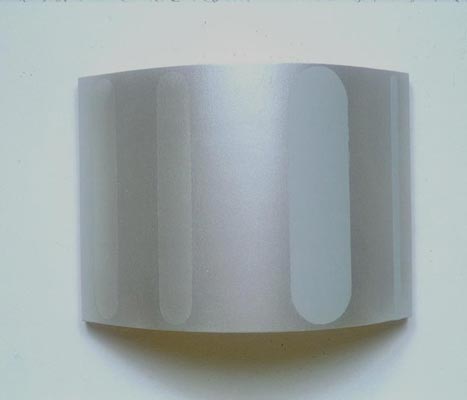
Trapeze, 2000.
Miscasceous acrylic, acrylic, and graphite on birch,
41 1/2" x 62" x 14 1/8".
|
|
The horizontal shapes push out from the wall in curves that are sometimes centered but more often off-center, to the right or left. Some are quite small (about 10 by 13 by 5 inches), well within the compass of our vision. Others are large (the largest is Trapeze, 41 1/2 by 62 by 14 1/8 inches), stretching our vision. But of course it depends on how far away you are, and where you stand (to the left or right), and those circumstances in turn affect how clearly you see things. The curves are like the panoramic arc of our vision, only pushing toward us rather than away. They appear like movie screens as well, only pushing toward us. |
|
This bending creates curves on top and bottom that are natural for us to feel, anyway, when looking out into larger vistas, which eventually include the circumference of the earth, the solar system, and the cosmos. Barnes has sprayed the surfaces with extraordinary smoothness and occasional gradations in acrylic paint--slightly silver, gray, or bronze--and so they appear almost imperceptibly pebbled like a movie screen or the retina at the back of the eye, receptors of light that not so much reflect images as modulate or capture light, so that the darkness of a doorway, for instance, is not a doorway but a shaped interruption of light, as we are also, standing there looking. Unlike Barnes' paintings of five years ago, these are fields of vision. Earlier, his painting of the surface stopped before the edge or left the grain of the wood to come through (most of the surface in one case). In them paint is brushed on, the wood is revealed, both are material, and gradations and changes are perceived in the paint itself and in our movement past the curve, which itself is centered. The universe of the new paintings is quite different. The materiality of the work is challenged. It is illusory, and ultimately illusionistic to a degree that the earlier paintings could not be because they insisted on their materiality, edges, and vertical stripes as demarcations of interiority. What was opaque is now translucent. From certain angles it appears that one can see into or through the surface, and that figures on the surface seem to float in space. The surface is actually completely covered, even when it fades toward the edges, sprayed rather than brushed, and becomes an ethereal rather than material realm, illusionism beyond even that which is traditionally achieved by perspective, shading, and layering. |
 Egotist, 2001. Miscasceous acrylic and acrylic on birch, 35" x 48 1/8" x 12 3/8". |
|
Now the vertical stripes are what Barnes calls "lozenges," with rounded corners. Some are narrow, but others have expanded to become rectangles. Some are even opaque and have a curious presence in the dematerialized space, like matter and anti-matter. But most are outlines in graphite, very precisely drawn in black or red. With their curved corners they seem to recognize the curved world in which they exist, as though there were really no way to contain it but only to embrace it, and particularly to embrace the movement that one experiences in passing by the curved surface. Sometimes the lozenges extend above and below the edges of the painting's surface, admitting to an even greater indefiniteness that lies outside the surface. |
 cil, 2000. Miscasceous acrylic and acrylic on poplar, 10" x 13 7/16" x 5". |
|
The rectangle controls our vision, as it always has. It is the picture, and we must respond to everything within the picture according to the rules that have been established by the artist. The edges are borders of a different world. But here we are forced into some kind of hyperbolic existence in which shapes disappear as we move past the curve, though we know they are still there, and the transparency or mirrored effect of space allows us to be behind things that appear on the surface. The painting becomes a body, a rudimentary reflection of our own, something into which we can and cannot see at the same time. Donald Goddard © 2001 |
Art Reviews Listings - Previous Review - Next Review
Art Review - NYArtWorld.com - NYAW.com. All artwork is copyright of the respective owner or artist. All other material © Copyright 2015 New York Art World ®. All Rights Reserved.
New York Art World ® - Back to Top